We already tested it
Asus ROG Ally review, release date, and price - Steam Deck’s first major competitor?
We already had the chance to test the new ROG Ally, a portable system with a lot of attractive features and some changes that aims to expand horizons beyond Valve and Steam.
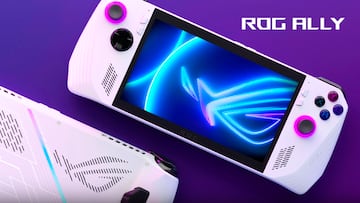
The launch of the Steam Deck in February 2022 has had a significant impact on the PC portable console market, paving the way for others to explore this path. In this scenario, Asus is preparing to compete in this emerging market with its own portable console, the ROG Ally, for which we already have a confirmed release date and price. It will be released on June 13 and the Extreme version, the most powerful and recommended, will cost $700. The standard Z1 version will cost $600. Can it compete with the Steam Deck? We have been able to test it extensively and these are our initial conclusions. But be warned: there’s competition.
Numbers rule and they shine
The first thing is to focus on the numbers that shine brightly on paper, although some may even seem unnecessary for a device with these features. We are talking about a Full HD (1080p) display with a refresh rate of up to 120Hz with an Adaptive Sync technology that seeks to give a crisp and clear vision that also benefits from being an IPS panel of 500 nits, which allows us to see much more vivid colors. To give us an idea, Nintendo Switch OLED has 383 nits and Steam Deck, has 400. Without a doubt, the level of contrast and brightness is the first thing that caught our eye when we tested the Asus console.

At CPU and GPU level, it has a new AMD Ryzen Z1 Extreme processor and AMD Radeon RDNA 3 graphics with 4G of RAM, 8.6 Teraflops in the case of the Extreme version (2.8 in the normal one) and 12 CU (4 in the standard one). All this in a very compact device of 280x111x21mm and a weight of 608 grams (Steam Deck weighs 669). To this we add 16 GB of LPDDR5 RAM and at the storage level, we have a 256 GB SSD for the Z1 and 512 for the Extreme, both with the possibility of expansion thanks to a Micro SD card.
On paper, we have a beast that is more powerful than its big competitor and, above all, has a 7-inch screen that looks really good. Our doubts lie in whether all this is necessary. We speak of such a high refresh rate when the community is working on the Deck to set it at 40hz and be able to get the most out of the battery with the most demanding games. The same goes for 1080p. Is it really necessary on a 7-inch screen? Experience tells us certainly not, although it is true that there is a higher density and sharpness for obvious reasons.

A matter of design: comfort and ergonomics
The platform is easy on the eyes because it has a very console-like layout and design. The controls are laid out in the Xbox style, with a right stick in an area below the four main buttons, four shoulder buttons, and a few more buttons on the back. It also has a fairly convincing D-pad for the fighting games we tested. On the front, we have two more Options-style actions and the usual start button, plus others that allow us to tinker with the platform’s parameters.
The analog sticks’ feel is smooth and precise, with no dead spots. We loved them. Honestly, when we think about the most obvious competitors we think the ROG Ally has, we think they are better than the Deck, the latest GPD, and the Switch’s joysticks. The rest of the buttons work properly (we miss having four rear buttons and not just two) and there is the addition of very Asus RGB colors that we will see around the joysticks. The console is beautiful, it’s comfortable and it feels good to play, we have no doubts about that.
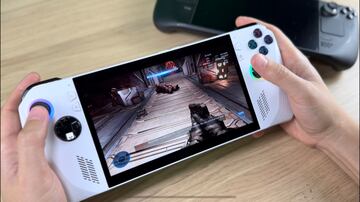
Features that make it easier to access games
The ROG Ally runs Windows 11 and everything that comes with it. On the one hand, we have a device that everyone is familiar with when they turn it on for the first time. On the other hand, we don’t have a dedicated operating system, which makes the “and that’s it” process we’re used to with these devices a bit more complex. In this sense, it reminds us a lot of the GPD Win series, which went in this direction, although here they have worked to make it more accessible to gamers. The touch screen is precise and very responsive, making it relatively easy to navigate even without a keyboard and mouse.
The shortcuts to make it more console-like are as follows. One of the buttons on the front of the device is used to access the Command Center, where we can choose the console’s performance mode (Turbo is the most demanding on the battery, but the one that gives the best results), the type of control, game profiles that we have done, limit or not the FPS, lower the refresh rate, change the resolution from 720 to 1080p (does not affect the games but the desktop, according to Asus) or add other functions, such as taking screenshots. We also have the option to change the layout and actions of the buttons and add macros and extra functions (such as taking a screenshot, exit to the desktop, etc.).
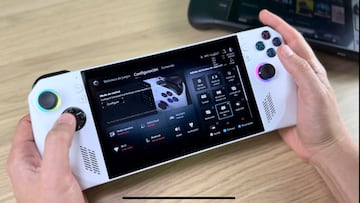
The other key is the Armoury Crate, a kind of game library where we add everything we have installed from our clients: Steam, Game Pass, Epic, etc. The system is well thought out on paper because it’s the way to compete with the actual menu of a console like Nintendo Switch or the deck itself. You turn on the console, Armoury Crate opens, and you select the game you want to play. There will be the titles you downloaded from wherever they are. Good, right? Not quite.
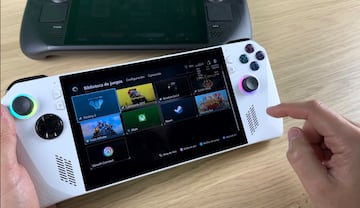
As we said, this is Windows for better or worse. When we tried to install Halo Infinite, we had to do it twice, and on several occasions, it would not boot when we tried to do it from the Armoury Crate. We’re not saying it’s the console’s fault, but something didn’t click, which is what happens with a proprietary operating system where you download a game, install it, hit play... and play.
The experience with Steam games is similar but with better results. In the end, the Asus hub is just a preliminary step that orders the games, but once you select the title, the Steam tab opens, loads, and prepares to launch. Usually no problem, but sometimes we had to reboot. In any case, the idea of a place where all the games can be found is appreciated and hopefully, its use will be optimized over time.
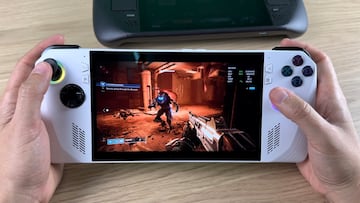
It’s time to play: preliminary considerations
In short, we tinkered with its possibilities, the available configurations and installed several games. Because we came here to play. So this is the experience we had with several titles, some that are examples of great AAA running on Steam Deck, others that are not directly playable on this platform, and others that come from customers other than Valve. The overall result is that in terms of performance, we are facing something superior to what we have seen on Deck, although sometimes not as stable as we would like due to the fact that the verified Valve, in the end, confirms a set of optimal settings, validated by the company and here we are pulling raw power.
Before we get to work, a few considerations. The mode that gives the best performance is Turbo, but it consumes an enormous amount of battery power and we may have to charge it within an hour. There are others, certainly, the performance mode is convincing for most games, but suffers with some of the most demanding. The quiet economy mode is designed for non-gaming purposes.
In addition, two technologies help improve performance: Resizable BAR and FSR (FidelityFX Super Resolution). Resizable BAR (Base Address Register) is a technology that allows the CPU to access all of the GPU’s memory at once, rather than in small chunks. In theory, this allows the CPU to process large amounts of GPU data more efficiently.
FidelityFX Super Resolution (FSR) is a technology that improves the visual quality of games by increasing their resolution without compromising performance. FSR uses advanced algorithms to increase the resolution from a lower-resolution image to a higher-resolution image in real-time with stunning results.
Pure brute force: how different titles perform on the ROG Ally
Cyberpunk 2077. It was one of the first games we wanted to test, as it’s a title that’s Deck verified, but it’s not the most solid thing we’ve played there. Performance at 1080p and with FSR enabled hovered around 40-45 fps most of the time indoors. It’s true that the game suffered more outdoors, with elements like rain and various enemy chases - as happened in the first few hours of play - dropping as low as 30 fps at times. Performance dropped to 720p and was much more stable, although the game suffered in terms of sharpness. In any case, we found it a good touchstone for the game’s overall performance.
Resident Evil 4 Remake. With Capcom’s game, we fiddled with some of the options because the framerate sometimes wobbled, although we managed to keep the first horde in the village between 40 and 45 frames per second, with a good level of detail. If you lock it at 30fps, there’s no problem because the game is immobile here. Although some of the details (shadows, lighting) aren’t the best, overall the game looks great at 1080p on the ROG Ally.
Destiny 2. The case of Destiny 2 was special because it is one of those games that are not compatible with Steam Deck because its anti-cheat system is not compatible with Linux-based operating systems. So it was an interesting approach to see in motion, not only for the performance but also for the fact that there are no such limitations in the ROG Ally. And the result is spectacular. The title runs smoothly at 60fps, with multiple on-screen enemies, huge bosses, and a very good visual level. It is one of those games that made us smile when we were able to enjoy it on a handheld and with the aforementioned analog sticks.
Elden Ring. It is one of the cases in which we have seen a clear improvement over its competitors. Elden Ring is a game that runs well between 45 and 55 frames per second, with a better level of detail than Steam Deck. The game looks particularly good on the ROG Ally, both in terms of colors - the screen and its brightness shine in these cases - and in terms of draw distance, texture quality... Less blurriness than on Valve’s console, no doubt.
Halo Infinite. We wanted to test how Game Pass games work on the system, and despite the problems we had with the installation, when it came time to play, by simply tweaking some settings to lock the framerate (Halo has an option to dynamically change the resolution to achieve the framerate), the title ran smoothly without any problems. It’s true that we also lowered the resolution to 768p (it wouldn’t allow 720), but overall the title is a spectacle on the screen with these settings. After that, the GPU load was significantly reduced and everything ran smoothly. Aside from Halo, we wanted to try some other smaller Game Pass titles to see if the excessive GPU usage we saw was due to the game or some other issue, but testing Ninja Gaiden Sigma (don’t look at us like that, you know how it is) ran at a rock solid 60fps, which makes sense.
We draw two conclusions from these tests. Firstly, in terms of performance, the console is capable of running top games at more than acceptable levels, although along the way it is not as plug-and-play as we expected and we will probably have to tweak some settings (it is a Windows PC, after all). Secondly, the turbo mode, designed to get the most out of the best games, consumes the battery in a brutal way. Titles of this level will last an hour or an hour and twenty minutes at the most, so it is something to keep in mind.
Conclusion
The Asus ROG Ally is a very attractive device. In terms of specifications, we have a platform that outperforms its main competitor, Steam Deck, since what it offers at the CPU and GPU level is potent, adding elements that are worth considering: a screen with more brightness (500 nits) and better colors, with comfortable and precise controls. Using Windows as an operating system has its advantages and disadvantages. On the one hand, it is easy to use because we are familiar with it and it allows us to access everything we would access on a PC (including all the game clients out there and not just Steam). On the other hand, not being a dedicated gaming system means that powering up and playing is not as smooth, and we have to deal with some hiccups despite Asus’ attempts to add interfaces that make things easier.
In terms of performance, the titles we tested easily meet expectations, but it is true that we have to tweak some settings along the way and, yes, the battery suffers when we are at maximum performance. The device will certainly be optimized in the future and its performance will improve, but today it is already a very good alternative to consider if you are aware of its many virtues and some shortcomings.